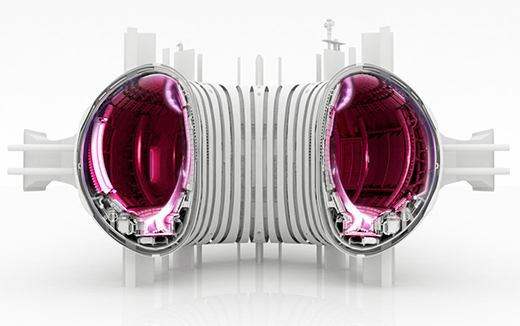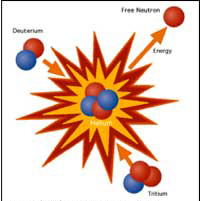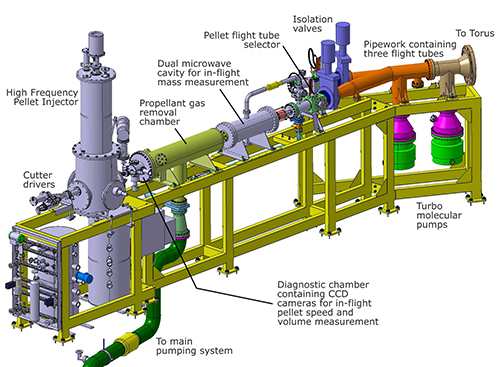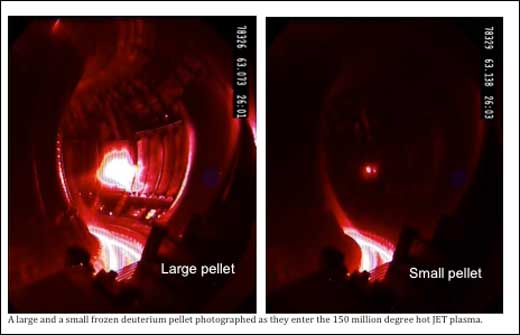Super cold meets super hot Understand article
To keep refuelling its reactor, the EFDA-JET facility fires frozen hydrogen pellets into 150 million°C plasma. But these pellets have an added benefit as well.

At EFDA-JET, near Oxford in England, we are working to develop nuclear fusion – the reaction that powers the sun – into a new energy source. Fusion energy is produced when nuclei collide and combine. As a fuel, JET uses two heavy isotopes of hydrogen: deuterium, which has a neutron as well as a proton, and tritium, which has two neutrons and one proton. When a deuterium nucleus collides with a tritium nucleus and fuses to create a helium nucleus, the energy released is so vast that 1 g of deuterium-tritium fuel can produce as much energy as burning 10 tonnes of coal. In the JET machine we heat the fusion fuel to more than 150 million°C. At this temperature, the fuel becomes the fourth state of matter, plasma, as the electrons are stripped from the atoms to create a gas of ions and electrons. This plasma is held in place inside the reactor’s donut-shaped reaction chamber by strong magnetic fields.
One of the problems facing fusion research is how to get the hydrogen fuel efficiently into the plasma at such high temperatures – the solution solves two problems.
Feeding the plasma

energy is produced when
super heavy hydrogen
(tritrium) and heavy
hydrogen (deuterium) collide
and transform into helium
and a free neutron.
Image courtesy of Nicola Graf
If we just put deuterium-tritium gas into the chamber, most of it is wasted and never reaches the centre of plasma. Instead, at such high temperatures, the gas molecules encounter charged plasma particles as soon as they get near the edge of the plasma. These charged particles collide with the gas, ionising it, and the ionised gas will itself become part of the plasma. Because most of this ionisation happens in the very edge of the plasma, these ionised particles will move along magnetic flux lines. Those particles that are too far out will be on field lines that do not close on themselves; instead of becoming part of the donut shape of plasma, they will hit a wall and be lost. Even particles slightly inside the plasma edge are likely to be knocked back outside when they collide with other plasma particles.
A more efficient solution is to shoot frozen hydrogen pellets into the plasma. If these pellets move quickly enough, they get much further into the plasma before evaporating and then becoming part of the plasma, so a smaller amount will be lost and almost all of the pellet particles will stay inside the plasma. So although we ultimately need to heat the fuel to hundreds of millions of degrees, we first need to cool it down to temperatures not much above absolute zero, where hydrogen freezes to become a solid. Systems to inject such pellets into plasmas have been tested for the past 20 years on a number of machines, including JET.
Added benefits
Recently, it was discovered that when these cold pellets enter the edge of the fusion plasma, they can trigger what is called an edge localised mode (ELM), a short sharp expulsion of energy from the plasma – a bit like a solar flare.
These expulsions of energy have become a hot topic in fusion research, as some are large enough to damage the walls of the reaction chamber. In JET, we have recently lined these surfaces with the metals tungsten and beryllium, which have the advantage of absorbing less hydrogen fuel than the carbon surfaces previously used. However, no gain ever comes for free and the new walls are more prone to damage by these ELMs.

Image courtesy of EFDA-JET
ELMs aren’t just triggered by pellets – they occur spontaneously in almost all ‘high performance’ plasmas and a lot of work is being done to reduce their impact. The ELMs occur at regular intervals and between ELMs, the pressure in the plasma builds up until it reaches a level that can no longer be sustained. At this point, the particles and energy are released abruptly in the next ELM. We are trying hard to find ways to avoid ELMs, but eliminating them has come at a high price, with the plasma performance dropping dramatically. Instead, we are now moving in the opposite direction by trying to induce more frequent ELMs that are so small that they don’t cause any damage.
This is where the discovery that fuel pellets ‘trigger’ ELMs comes in – as well as refuelling the reactor, they now have ELM control added to their repertoire. This can be seen as the pellet ‘tickling’ the edge of the plasma, making it sneeze. To tickle the plasma edge, the pellet does not need to get far into the plasma so we can use much smaller pellets than are needed for putting fuel into the middle of the plasma. This is lucky, as we need to trigger ELMs up to 50 times per second and we would be putting too much deuterium-tritium into the plasma if we used the standard size of pellets.

high-frequency pellet injector (HFPI) and transmitted through 1 cm diameter pipes over
distances of 10-15 m at rates up to 50 pellets per second. After the pellets are ejected from
the HFPI, the diagnostic chamber uses cameras to check the pellet’s size and speed.
The pellets then enter one of three flight tubes, each of which enters the reaction chamber
at a different place. In this schematic representation, the size of the HFPI is exaggerated by
a factor of about 3 with respect to the JET machine
Image courtesy of EFDA JET
With this new purpose in mind, a new versatile high-frequency pellet injector has been put into operation at JET. It works a bit like a machine gun and can fire long sequences of pellets of a variety of sizes into the plasma. Up to 15 large (10–50 mm3) pellets per second can be injected to fuel the plasma but we can also use this device to shoot up to 50 small (2–3 mm3) pellets per second in order to trigger small ELMs.
This fuel machine gun has brought fusion as an inexhaustible energy source not one, but two steps closer. The process of fuelling a hot plasma is now more efficient, and a seemingly problematic side effect has been harnessed as a benefit. We now know how to cope with ELMs, one of the trickier challenges for a functioning fusion reactor.

Image courtesy of EFDA-JET
The pellet injector, manufactured by the PELIN company from St. Petersburg in Russia, produces a continuous stream of deuterium ice inside a vertical screw, cooled by liquid helium. With the temperature above the freezing point of deuterium at the top of the screw and below freezing at the bottom, the deuterium enters as gas at the top before condensing and freezing as it moves down through the screw. When the screw turns, it pushes the 18 K (-255 °C) deuterium out at the bottom. From this solid material, pellets are cut as tiny cylinders before being shot towards the plasma by the equivalent of an air gun. If the ice is too hot, the pellets will melt on their way towards the plasma; if it is too cold, the ice is so hard that it shatters when it is cut. As the pellets leave the pellet ‘gun’, their troubles are not over. They have to travel through a 10-20 metre long, rather tortuous, rollercoaster of pipes before they can do their job in the plasma.
More about EFDA-JET
The Joint European Torus (JET)w1 investigates the potential of fusion as a safe, clean and virtually limitless energy source for future generations. It can create the conditions (100-200 million °C) in the plasma sufficient for the fusion of deuterium and tritium nuclei to occur, and it has achieved a maximum fusion power output of 16 MW. As a joint venture, JET is collectively used by more than 40 European fusion laboratories. The European Fusion Development Agreement (EFDA) provides the platform to exploit JET, with more than 350 scientists and engineers from all over Europe currently contributing to the JET programme. While deuterium-tritium fuel will be used in fusion power plants, fusion experiments normally use deuterium-deuterium reactions to avoid working with radioactive tritium. JET is currently the only fusion device licensed for working with tritium. It does so very rarely for specific experiments.
EFDA-JET is a member of EIROforumw2, the publisher of Science in School.
Web References
- w1 – Learn more about EFDA-JET.
- w2 – EIROforum is a collaboration between eight of Europe’s largest inter-governmental scientific research organisations, which combine their resources, facilities and expertise to support European science in reaching its full potential. As part of its education and outreach activities, EIROforum publishes Science in School.
Resources
- Warrick C (2006) Fusion – ace in the energy pack? Science in School 1: 52-55.
- The European fusion education network, FuseNet, hosts material that can be used in schools
Institutions
Review
This article describes the research activities behind the development of a method to produce electric energy from the fusion of light atomic nuclei – just like the sun does. The largest fusion experiment – the JET – is located in Culham, UK.
The article gives physics or science teachers a short overview of how fusion works and describes in detail how to supply a fusion reactor with fuel using frozen hydrogen pellets. Therefore this article would be useful not only for physics but also for chemistry or for discussions on energy production and sustainability.
The article stimulates comprehensive questions like:
- How does fusion work in general?
- What is plasma? Describe ways to generate plasma.
- Describe the different states of matter.
- Describe a way to feed a fusion tokamak-like reactor. What problems may occur?
Gerd Vogt, Higher Secondary School for Environment and Economics, Yspertal, Austria





